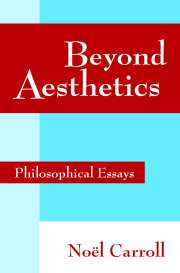Book contents
- Frontmatter
- Contents
- Foreword by Peter Kivy
- Introduction
- PART I BEYOND AESTHETICS
- PART II ART, HISTORY, AND NARRATIVE
- Art, Practice, and Narrative
- Identifying Art
- Historical Narratives and the Philosophy of Art
- On the Narrative Connection
- Interpretation, History, and Narrative
- PART III INTERPRETATION AND INTENTION
- PART IV ART, EMOTION, AND MORTALITY
- PART V ALTERNATIVE TOPICS
- Notes
- Index
Historical Narratives and the Philosophy of Art
Published online by Cambridge University Press: 19 January 2010
- Frontmatter
- Contents
- Foreword by Peter Kivy
- Introduction
- PART I BEYOND AESTHETICS
- PART II ART, HISTORY, AND NARRATIVE
- Art, Practice, and Narrative
- Identifying Art
- Historical Narratives and the Philosophy of Art
- On the Narrative Connection
- Interpretation, History, and Narrative
- PART III INTERPRETATION AND INTENTION
- PART IV ART, EMOTION, AND MORTALITY
- PART V ALTERNATIVE TOPICS
- Notes
- Index
Summary
SETTING THE STAGE
If one surveys the canonical history of the philosophy of art in the English-speaking world – as it is enshrined in numerous textbooks and anthologies – it is difficult to resist the conjecture that it has been driven by the development of the avant-garde. This may appear to be a controversial hypothesis because it does not seem to square with the field's explicit understanding of itself. For on that understanding, the dominant view is that the philosophy of art has been concerned with successive attempts to characterize the nature of art from an ahistorical point of view. However, a close look at the way in which later philosophers have dialectically constructed their views against the backdrop of earlier, rival philosophies of art reveals an unmistakable trend – namely, later philosophers in the historical series are attempting to come to terms with certain recent mutations in the practice of art that were not accommodated by the proposals of earlier philosophers of art.
For example, as is well known, Clive Bell's dismissal of imitation theories of art and his defense of formalism were motivated by his perception of the conceptual failure of earlier approaches to art to accommodate neo-impressionism. R. G. Collingwood's philosophy of art attempts to create a space for the modernist poetics of Eliot, Joyce, Pound, and Stein; while the theories of George Dickie and Arthur Danto emerge in the process of taking Dada seriously.
In his recent book, Definitions of Art, Stephen Davies draws a distinction between functional and procedural definitions of art.
- Type
- Chapter
- Information
- Beyond AestheticsPhilosophical Essays, pp. 100 - 118Publisher: Cambridge University PressPrint publication year: 2001
- 1
- Cited by



